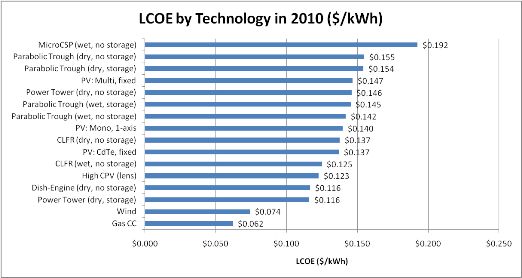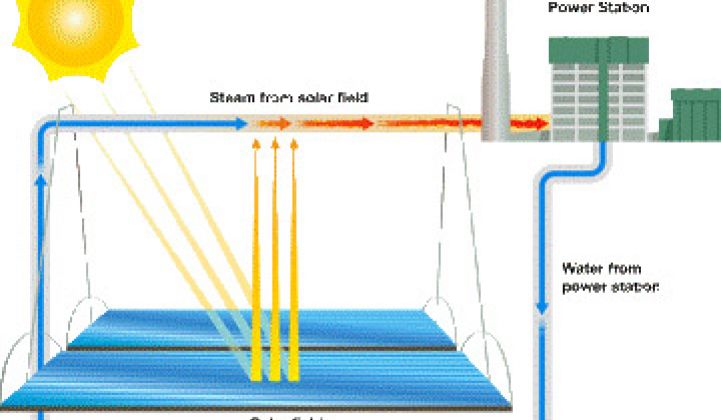While attending the World Future Energy Summit in Abu Dhabi, I was able to meet with Milton Venetos, the VP of Systems Engineering for AREVA Solar.
Following up on the article written by Eric Wesoff on Solar-Augmented Power Production, I asked Milt some questions about the economics of such power booster projects.
AREVA Solar has a concentrating solar offering known as Compact Linear Fresnel Reflector (CLFR). As analyzed in the recently released GTM Research CSP 2011 report, CLFR is one of the lowest cost solar options. As shown in the chart below, CLFR is about $0.125/kWh for a utility-scale plant in the U.S. Southwest (including the impact of the 30% Treasury Grant and accelerated depreciation). While this is low relative to other solar options, it is still well above wind and natural gas generation costs.

So, what can be done to reduce CSP's costs? One option is to get rid of the steam turbine / power block, which represents a big chunk of the total project cost and construction time for a standalone CSP plant. This can be accomplished by locating the solar field adjacent to an operational coal or natural gas plant and simply feeding steam into the existing power block. There are several such solar booster projects worldwide, and the ones with cost data follow (from the GTM Research CSP 2011 report):
|
|
Project Name |
Developer |
Gross Capacity (MW) |
Capital Cost ($/W-ac) |
Capacity Factor |
LCOE ($/kWh) |
|
1. |
Cameo |
Abengoa Solar |
1 |
$4.50 |
20.3% |
$0.21 |
|
2. |
Kogan Creek |
AREVA |
42.8 |
$1.90 |
13.6% |
$0.15 |
|
3. |
Martin NGSEC |
FPL |
75 |
$6.35 |
24% |
$0.24 |
|
4. |
Yazd ISCC |
|
67 |
$2.06 |
27% |
$0.09 |
The costs per watt seem to be all over the place for these 4 projects. Why? Details for each project follow.
1) Cameo was a small project, so the costs/W are higher than would be expected from an optimally sized booster (40+ MW).
2) Kogan Creek has a cost of $1.90/W, which is in line with what you might expect to just build a solar field. But the LCOE looks high, due to a low capacity factor. Milt explained that Kogan Creek is a dry cooled, supercritical coal plant, so the thermal energy is supplied to the power plant at a lower pressure and expanded to a higher pressure, which reduces the thermal to electric energy conversion--in turn lowering the capacity factor.
3) Martin looks very expensive, perhaps because hurricanes in Florida required that the frames and mirrors needed to be heavy duty. The Martin plant is a combined cycle plant, so it is able to convert the solar thermal energy to electricity at a higher efficiency.
4) Yazd looks really cheap. The data comes from the government of Iran. No further comment.
The bottom line remains, which is that solar booster projects should have better economics than standalone CSP plants that also need to build a power block. But there are a couple of drawbacks.
i) the size of the solar field is limited by the extra capacity in the existing power block (usually less than 10% of the rated capacity)
ii) independent developers probably would shy away, as this would require coordinating the project with the owner of the coal/gas plants. So the only companies that can build these solar boosters are the owners of the coal/gas plants.
iii) getting a utility to sign a PPA for solar electricity from a hybrid plant could be complicated. Inland Energy got PPAs signed for its 2 projects (Victorville & Palmdale). But neither of these projects have been completed.
Nonetheless, the hybrid solar idea seems compelling, and AREVA Solar, with the most land-efficient CSP technology, is betting that there is real money to be made here. And they are not alone. There are several other solar booster / ISCC projects in operation/under development worldwide including:
|
Project Name |
Developer |
Gross Capacity (MW) |
|
|
1. |
Archimede |
ENEL |
5 |
|
2. |
El Kuraymat |
Solar Millennium |
20 |
|
3. |
ISCC Algeria |
Abener Energía |
20 |
|
4. |
ISCC Morocco |
Abener Energía |
20 |
|
5. |
Palmdale Hybrid |
Inland Energy |
50 |
|
6. |
Victorville 2 Hybrid |
Inland Energy |
50 |
All of the projects listed above are new build, natural gas-fired combined-cycle plants. Adding a solar boost to a new build combined-cycle plant allows for a high (> 40%) solar thermal to electricity conversion efficiency. For the steam temperatures and pressures produced by trough and CLFR solar fields, this is a higher conversion efficiency than can be obtained with a standalone CSP plant (~37%).
If they can overcome the obstacles highlighted above, solar booster projects may prove to be a promising niche for CSP manufacturers, especially in countries that are building new combined-cycle gas plants.



